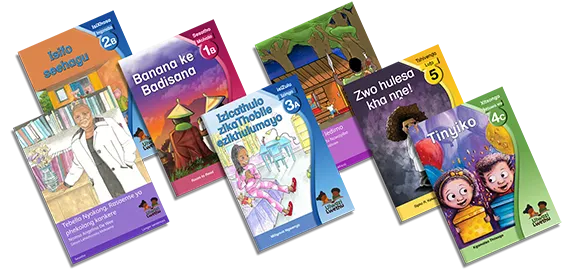For Educators
Ulwazi Lwethu graded readers are specially designed and developed for classroom use based on the latest research in African language literacy teaching – enabling educators to teach and encourage learners to read fluently, independently and for meaning in the early grades.
Graded readers are levelled to systematically improve the reading fluency and comprehension skills of Foundation Phase learners. Readers in each Level have been designed to take into consideration word and sentence complexity, the number of words and sentences per page, appropriate CAPS Life Skills Curriculum topics, decodability and the ratio of illustrations to text on a page.
| Levels | Description | Recommended for Grades |
|---|---|---|
| Early Emergent | R | |
| Level 1 | Emergent | 1 |
| Level 2 | Developing | 1, 2 |
| Level 3 | Early fluent | 2, 3 |
| Level 4 | Fluent | 3 |
| Level 5 | Independent | 3 |
Storybook levels are clearly explained and will guide your storybook selection process.
| Levels | Description |
|---|---|
| Level 1 - First words | Single words or a short simple sentence; up to 11 words per page. |
| Level 2 - First sentences | Two or three short sentences; 11–25 words per page. |
| Level 3 - First paragraphs | One or two short paragraphs; 26–51 words per page. |
| Level 4 - Longer paragraphs | Two or more paragraphs; 51–75 words per page. |
| Level 5 - Read aloud | Fewer pictures; more than 76 words per page. |
These levels refer to the reading level of a child and have no significance on the grade of a learner.
See detailed breakdown of the Guidelines for Graded Readers and Storybooks hereStorybooks are an essential component of supporting literacy practice for children. Below are a few key points to keep in mind when using Storybooks for CAPS Reading Requirements (Shared Reading):
- Practice reading a storybook aloud so that when you read a story to children, you are familiar with the words and can focus on bringing out the meaning. Use different voices for different characters and sound effects. Have fun with the story!
- Work with the whole class to read a storybook. Each child should ideally have a copy of the anthology. You can use one storybook over a few lessons (up to a week). Shared reading is allocated 15 minutes a day in CAPS.
- For the first lesson, begin by looking at the front and back cover of the storybook with the class. Examples of questions to ask: What words can you read on the cover? What is the name of the storybook? Who wrote the story? Who drew the pictures? What do you think the story is about (from the picture and name)?
- Read the story clearly, page by page, while children listen with their books closed. Check that children understand the story. Ask for their responses to any aspect of the story.
- Then, read the story again while children follow the words silently in their own books or read aloud with you. Ask general questions, for example: Who is this story about? Who else is important? What happens? Why do you think that happened?
- Ask questions about the pictures: What do you think this person is feeling? What or where is this place in the picture? Which picture did you like most, why? What do you see happening in this picture?
- Develop children’s language awareness by using words from the story to point out: selected letter sounds (single sounds, and combined sounds), sentence and word structures (e.g. vocabulary and simple grammar), and punctuation marks.
Teachers Guide
The Teacher Guides supports and enables teachers to use the Anthologies, Big Books, Graded Readers, Worksheets, Storybooks and Classroom Libraries effectively.
By using the different reading methodologies (Teacher Read Aloud, Shared Reading, Group Guided Reading, Paired Reading and Independent Reading) with the materials, teachers will be able to teach and encourage learners to read fluently, independently and for meaning in the early grades.
Teacher Guides gives a detailed description of each of the reading resources and unpacks why, what, when and how to use each of the reading resources.
All the teacher guides are bilingual, available in English and an indigenous language.




